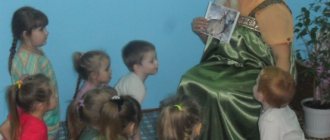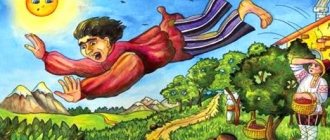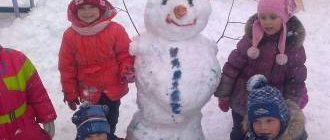Speech development according to the program “From birth to school” for the middle group
The Program brings to the fore the developmental function of education, ensuring the formation of the child’s personality and orienting the teacher to his individual characteristics, which corresponds to modern scientific concepts of preschool education about the recognition of the intrinsic value of the preschool period of childhood.
Program "From birth to school" for the middle group
Note! The standard program according to Ushakov’s method is built on the principles of a humane and personal attitude towards the child and is aimed at his comprehensive development, the formation of spiritual and universal values, as well as abilities and competencies.
The implementation of this principle ensures that national values and traditions are taken into account in education and makes up for the shortcomings of spiritual, moral and emotional education. Education is considered as a process of introducing a child to the main components of human culture (knowledge, morality, art, work).
The main criterion for selecting program material is its educational value, the high artistic level of the cultural works used (classical and folk - both domestic and foreign), the possibility of developing the child’s comprehensive abilities at each stage of preschool childhood.
Long-term planning of classes with middle group children
The long-term plan for the middle group is aimed at developing in preschoolers the concept of human uniqueness. A conversation with children on the topic “Do we need to learn to speak correctly” will help to understand what and why they will do in speech development classes. The teacher also explains to the kids the articulation of sound. Special exercises are selected to pronounce a distinct sound. You can use the literature of V.V. Gerbova “Speech Development in Kindergarten”.
Features of the Federal State Educational Standards program
A federal educational standard for preschool education has been developed for the further development and successful education of each preschooler, taking into account age characteristics. The goal of the Federal State Educational Standards program is to develop free communication with adults. Children in the middle group learn to carry on a conversation with ease.
Note! The lexical and pronunciation aspects and the grammatical structure of speech play a huge role in this. Children get used to using a variety of word formation methods, as well as complex sentences of different types.
Didactic games for coherent speech in the middle group
Didactic games are a valuable means of cultivating mental activity. Using this method, mental processes are activated. Thanks to this process, the child develops an interest in learning something new. The teacher prepares an exciting game, which should cause deep satisfaction in preschoolers. Thus, the process of acquiring knowledge is greatly facilitated.
- A game called "Broken Phone". The entertainment is aimed at developing auditory perception and speech hearing in preschoolers. Children must follow the rules of the game. The word must be conveyed in such a way that children sitting nearby cannot hear. Whoever passed the word incorrectly, i.e. damaged the phone, moves to the last chair. Game action: whisper a word into the ear of the player sitting next to you.
- Game “How many words with the sound S?” The main goal is to reinforce the identification of the C sound in a word by presentation. A plot picture is given, in which there are many subject pictures, including those containing the sound S in the title. Game progress: children are allowed to look at the picture and name the necessary objects, the one who names the most objects wins. Children place chips on the pictures they find, and the presenter then checks whether the task was completed correctly and determines the winner.
To develop speech, you need to select story pictures and children’s favorite songs. Before conducting a lesson, you should carefully consider and study the subject. When telling fairy tales, you need to regularly ask which character they liked the most.
Summary of educational activities for speech development according to the Federal State Educational Standard in the middle group of preschool educational institutions. Wild animals
Development of a GCD outline for speech development in the middle group according to Federal State Educational Standards standards
Age group 4-5 years Topic “Wild Animals” Leading educational area: speech development. Goal: expanding the understanding of wild animals. Objectives: Educational:
- use prepositions and descriptive adjectives in speech;
- practice word formation of nouns with diminutive suffixes; - practice selecting antonyms and synonyms. Developmental:
- promote the development of emotional vocabulary;
- develop independent coherent speech based on didactic material; — develop children’s speech, memory, visual perception, attention, curiosity; Educational:
- cultivate love and respect for nature.
Types of children's activities: play, communication, motor Methods and techniques: verbal (questions, riddles, conversation); visual (pictures and illustrations, toy hare); practical (didactic games) Preliminary work: - examining pictures of wild animals - clarifying ideas about wild animals (conversation) - reading stories about animals Materials and equipment : pictures of wild animals: squirrels, bears, foxes, wolves, moose;
board, toy hare. Progress of GCD:
I. Motivational and incentive: Org. Moment: Greeting
(children stand in a circle).
Let's stand side by side, in a circle, Say "Hello" to each other. Let's clap our hands and stamp our feet. If everyone smiles, a good morning will begin. Good morning, boys and girls! (children sit on chairs) Educator: Guys, hear someone knocking and rustling quietly under the door. Now I'll see who it is? (looks behind the door). Guys, our guests asked not to identify themselves, but to try to guess who they are. If we solve all the riddles, a guest from the forest will come to us. Listen to the riddles. (As you guess, pictures with animals other than a hare) are put on the board. II. Main part: Riddles. 1. She is very cunning, She ate a bun in a fairy tale. He steals chickens and roosters. Who is ready to name it? (Fox) 2. He ate seven kids, he wanted to eat three piglets. He prowls the forest at night, looking for food for himself. It's scary to hear the mouth click. He, fierce, gray... (Wolf) 3. Who carried Masha in a basket And sat on a stump, And wanted to eat a pie. Who sleeps in a den in winter, Does the forest tremble from his roar? (Bear) 4. Touching the grass with his hooves, a handsome man walks through the forest. He walks boldly and easily, with his horns spread high. (Moose) 5. Who deftly jumps through the trees and flies up into the oak trees? Who hides nuts in a hollow and dries mushrooms for the winter? (Squirrel) 6. Who loves carrots and jumps deftly. He spoils the garden beds and runs away without looking back. (Hare) Teacher: (looks behind the door and takes out a toy hare). Guys, our hare is very timid, timid, he is afraid of something, that’s what they call him: “cowardly bunny.” And to show that we are kind and will not offend anyone, let's play the game “Name it kindly.” Didactic game “Name it affectionately” (the teacher shows on the board and names the animal, and the children call it affectionately) Fox - fox, fox Squirrel - squirrel Wolf - top Bear - bear Elk - moose Hare - bunny, bunny, bunny, bunny. Educator: Well done, guys! Let's look at the board and say what we can call everyone in one word! (children's answers) That's right, animals! Where do these animals live? (in the forest) They are called “wild animals” (children repeat in chorus) Phys. minute: Finger gymnastics “Animal fingers” Finger-bunny, (bend the little finger on the right hand) Finger-wolf, (bend the ring finger on the right hand) Gray wolf click with teeth, Finger-red fox, Fox-fox, (bend the middle one finger on the right hand) Finger - a hedgehog, (bend the index finger on the right hand) Finger-bear, (bend the thumb on the right hand) And the fist looks like a bump, (raise up the right hand clenched into a fist). Educator: Guys, the bunny told me in my ear that all the animals want to play with you. The game is called "Say it the other way around." Didactic game “Say the other way around” The moose is big, and the bunny... is small. The squirrel is weak, but the wolf... is strong. The fox has a long tail, and the hare... has a short tail. The bunny is cowardly, and the bear is... brave. The squirrel is small, and the bear is...big. The wolf is strong, but the bunny is... weak. Educator : You are a little tired, I suggest you play. We went out onto the meadow and made a circle. (children stand in a circle) Didactic ball game “Which one?” Which?" (The teacher throws the ball one by one, and the children select words that describe this animal) What is a fox? (cunning, red-haired, fluffy, beautiful) What kind of hare? (cowardly, long-eared, small, fluffy, gray) What kind of bear? (clubfooted, clumsy, big, strong, brown) What kind of squirrel? (agile, fast, fluffy, red) What kind of wolf? (angry, angry, toothy, scary, gray) Educator : Guys, it’s time for our animals to go home to the forest! After all, they are wild animals and cannot live with humans. Let's help them find their way home. Each animal has its own home in the forest, and these homes are different. To send all wild animals to the forest, you need to correctly name the house of each animal (if the answer is correct, the teacher removes the image of the animal from the board) Didactic game “Who lives where” The fox lives in ... a hole (removes the image of the fox). The bear lives in... a den (removes the image of the bear). A squirrel lives in ... a hollow (removes the image of a squirrel) A wolf lives in ... a den A hare lives under ... a bush. Educator : And the elk lives in the forest, but he has no home. He lies right on the ground, under a tree. Guys, all the animals are already in the forest and thank you very much for your help. And they really enjoyed playing with you. I think that they will come to visit us more than once. III. Reflection: What animals did we talk about today? Did you like the lesson? What did you like most? Source:
We recommend watching:
Summary of educational activities for children with parents in the middle group. Do-it-yourself doll GCD for the development of speech of children in the younger group. Wild animals in the fall Abstract of educational activities for speech development in the middle group on the topic: Wild animals Abstract of educational activities in kindergarten in the junior group. Wild animals
Similar articles:
Lesson in the middle group “Winter clothes”
Math lesson notes “Number 1”. Middle group





